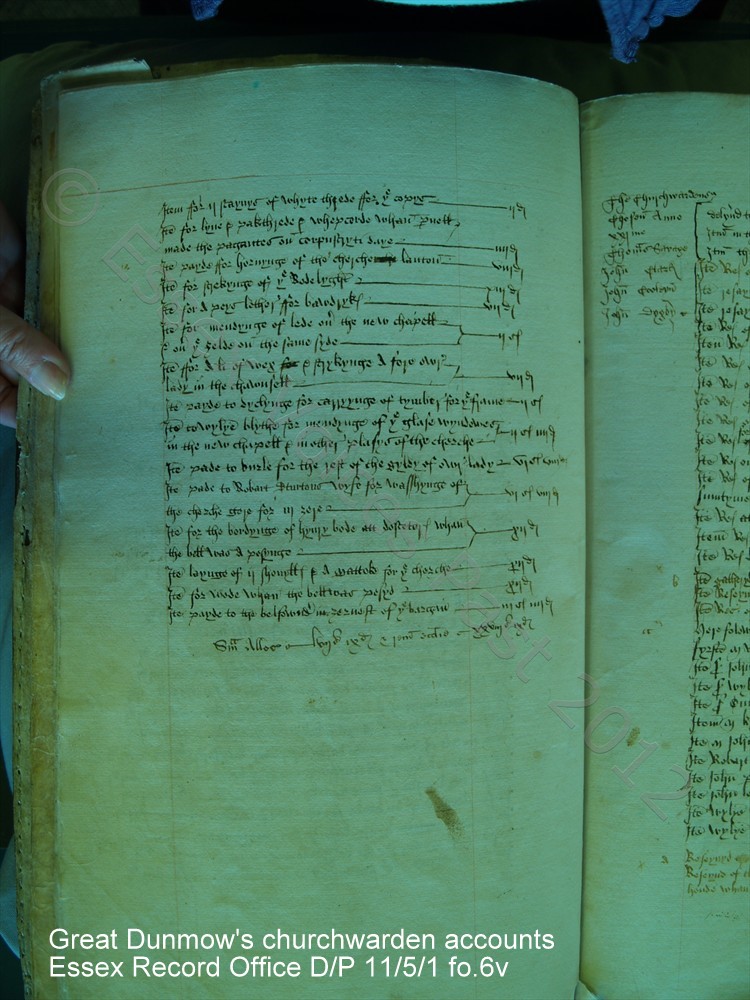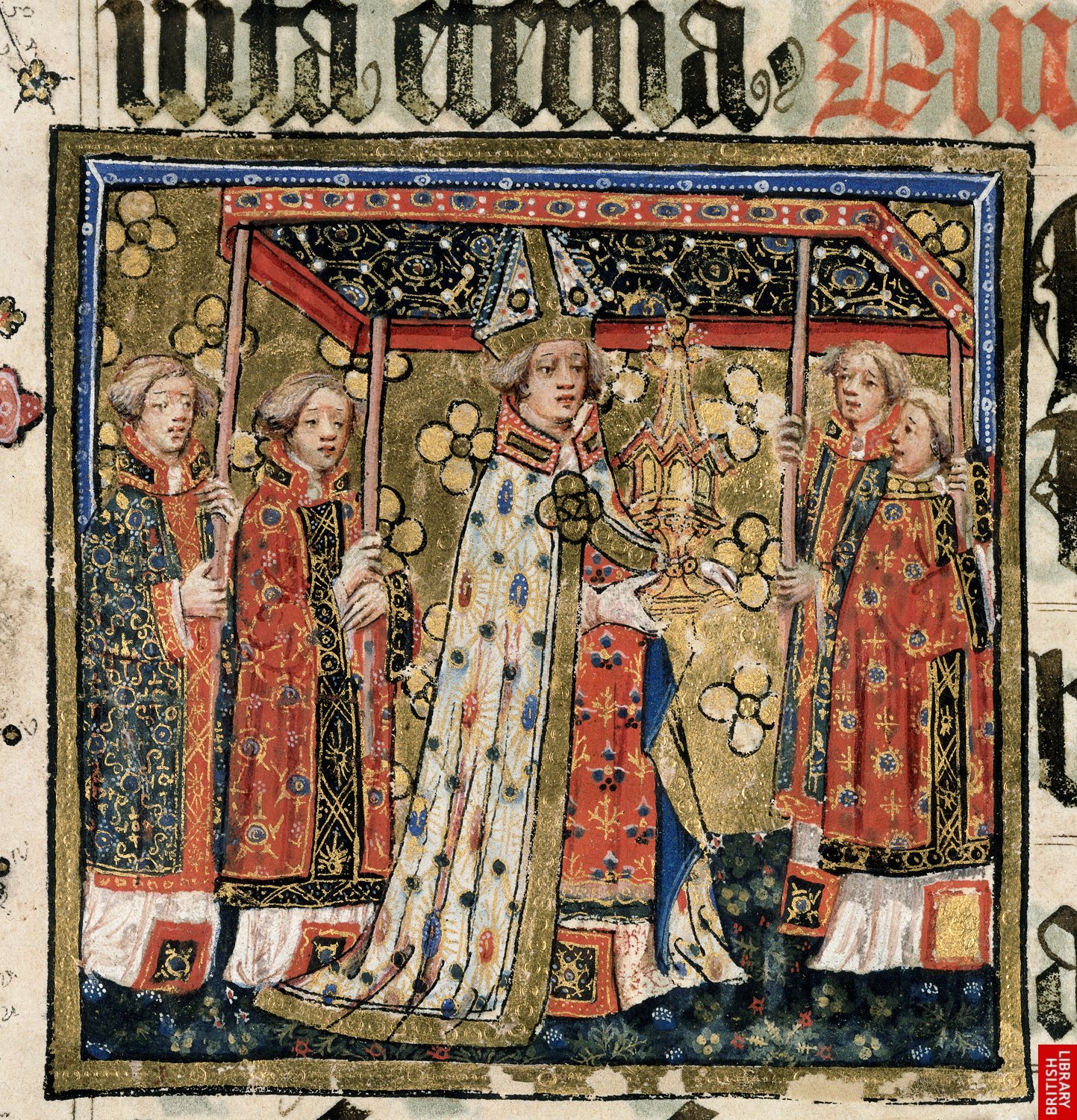Transcript fo. 7r: Tudor Great Dunmow 1527-1529
Transcription of Tudor Great Dunmow’s churchwardens’ accounts (1527-9)
| [in the left margin]The churchwardens Choson Anno xxjmc [21st regnal year of Henry VIII sometime between April 1529-April 1530] Thom[a]s Savage John Clark John Cooleyn [Collin?] John Dygby [This margin note appears to be entered by a different set of churchwardens (or scribe) at a later date to the rest of the page. Analysing the churchwardens’ accounts chronologically show that this folio appears to relate to a period sometime between 1527 and 1529] |
|
| 1. Dely[er]nd to the sayd wardens the s[um]ma aforsayd [delivered to the said wardens the sum aforesaid] | xxviijs ixd [28s 9d] |
| 2. Item in the hands of wyll[ia]m Sturton [Item in the hands of William Sturton] | xs [10s] |
| 3. It[e]m the halfe yere rent remaining ?? [Item the half year remaining ?] | xvijs jd [17s 1d] |
| 4. Ite[m] res of Thom[a]s wete for the latt payment for hys howse [Item received of[f] Thomas Wete for the late payment for his house] | iijli vjs viijd [£3 6s 8d] |
| 5. Ite[m] resayvyd att the fyrst maye [Item received at the first may] | xviijs xd [18s 10d] |
| 6. Ite[m[ resayvyd att Corpuscrysty feste [Item received at Corpus Christi feast] | xxjd [21d] |
| 7. Ite[m] res of John foster ych was gatheryd wha[n] he was lorde [Item received of John Foster which was gathered when he was lord] | liijs iiijd [53s 4d] |
| 8. Item res of M[ister] Joyner [Item received off Mister Joyner] | vli [£5] |
| 9. Ite[m] res of my lady gatys for washe of ye torchys [Item received off my lady ?? for washing of the torches] | xijd [12d] |
| 10. Ite[m] res of the good ma[n] whale for hawys [Item received off the good man Whale for house] | xs [10s] |
| 11. Ite[m] res of Nyclas Aylett of ye gyfte of mawde bemysche [Item received off Nicholas Aylett of [from] the gift of Maud Bemysche | iiijs [4s] |
| 12. Ite[m] res of poole for halfe yerys rent of hawys [Item received of Poole (or Paul) for half years rent of house] | iijs iiijd [3s 4d] |
| 13. Ite[m] res \for/ of ye hosker yt was solde of the cherchys [Item received for the ?? it was sold of [from] the church] | xs [10s] |
| 14. Ite[m] res on Alhalows daye gatharde in the cherchye [Item received on All Hallows day gathered in the church] | xs xid [10s 11d] |
| 15. Ite[m] res of Wylyem Sturton of ye gyfte of M[aster] Sturton [Item received off William Sturton of the gift of Master Sturton] | |
| 16. sumtyme vycar of thys chyrche [sometime vicar of this church] | lijs iiijd [53s 4d] |
| 17. Ite[m] res att the laste maye [Item received at the last May] | xxvjs [26s] |
| 18. Item res att corpuschrsti feste nexte folowynge [Item received at Corpus Christi feast next following] | xxs iiijd [20s 4d] |
| 19. Ite[m] res A hole yerye rente [Item received a whole years rent] | xxxiiijs ijd [34s 2d] |
| 20. Ite[m] gatheryd i[n] the cherche for p[ar]te of the cherche fence [Item gathered in the church for part of the church fence] | iijs vd [3s 5d] |
| 21. Ite[m] reseyvyd for the olde tymber of the same fence [Item received for the old timber of the same fence] | iiijd [4d] |
| 22. Ite[m] Res of Thom[a]s Savage towards the same fence [Item received off Thomas Savage towards the same fence] | xiid [12d] |
| [From here onwards starts the list of names of all the heads-of-households within the parish and their individual contributions towards the church’s bells. This list will be on a future blog] | |
Commentary
Line 4: Whoever Thomas Wete was, he either hadn’t paid his rent for a long time or rented a large piece of church land/house. £3 6s 8d was a very large sum of money for the time equating to very roughly three or four months wages for a labourer.
Line 5 & 17: This must have been money collected for events held on May Day. The fact that there are two entries on this page for May Day gives unwitting testimony that the churchwardens hadn’t been as diligent as they should perhaps have been. They appear to have been ‘catching up’ on their yearly accounts long after the event.
Line 6 & 18: This is money collected during the festivities held on Corpus Christi day. See my post on Great Dunmow’s Corpus Christi events. Again, as per the commentary above on May Day, these two entries for two years show that the churchwardens were writing up the church’s accounts years after the actual event.
Line 7: John Foster had been playing the lord of misrule – possibly during the Christmas celebrations in the parish.
Line 8: Mister Joyner’s gift of £5 was a large sum of money for an unspecified reason. However, at the bottom of this folio and on subsequent folios, the churchwardens’ document each house-holder in the parish and their individual contribution towards purchases a new church bell. Mister Joyner is not documented within the list so it is entirely plausible that this entry is his individual contribution to the collection. Perhaps he didn’t give money at the time the collection took place, or maybe he didn’t live in the town. Bearing in mind that the entries on this page were written up some years after the events they were recording (as shown by the May Day and Corpus Christi feast entries), it is therefore unsurprising that Mr Joyner’s substantial gift appears separate to the list of the town.
Line 9: I would love to be able to read the missing word in this line! Can anyone help? Were the ladies washing torches! This line probably relates to torches that were used during the funerals of the great and good of Dunmow. The elite were buried within the church and torches were kept lit around their bodies on the night before their funeral. But I’m not sure where the ‘ladys’ come into this – unless the word is ‘lads’?
Line 11: This gift from Mawde Bemysche is probably the result of her bequeathing money to the church in her (now lost) will.
Line 15 & 16: This is money from the old vicar, Robert Sturton’s, now missing will. William Sturton was possibly Vicar Sturton’s nephew or other relation. The Sturton family were a very large and important elite family within Tudor Great Dunmow.
Notes about Great Dunmow’s churchwarden accounts
Great Dunmow’s original churchwardens’ accounts (1526-1621) are kept in Essex Record Office (E.R.O.), Chelmsford, Essex, D/P 11/5/1. All digital images of the accounts within this blog appear by courtesy of Essex Record Office and may not be reproduced. Examining these records from this Essex parish gives the modern reader a remarkable view into the lives and times of some of Henry VIII’s subjects and provides an interpretation into the local history of Tudor Great Dunmow.
*-*-*-*-*-*-*-*-*-*-*-*-*-*-*-*-*
This blog
If you want to read more from my blog, please do subscribe either by using the Subscribe via Email button top right of my blog, or the button at the very bottom. If you’ve enjoyed reading this post, then please do Like it with the Facebook button and/or leave a comment below.
Thank you for reading this post.
You may also be interested in the following
– Index to each folio in Great Dunmow’s churchwardens’ accounts
– Great Dunmow’s Churchwardens’ accounts: transcripts 1526-1621
– Tudor local history
– Pre-Reformation Catholic Ritual Year
– Unwitting testimony
– Great Dunmow’s Corpus Christi events
– Christmas in a Tudor town
– Reformation wills and bequests
– The Sturton family of Great Dunmow and Great Easton
© Essex Voices Past 2012-2013.







